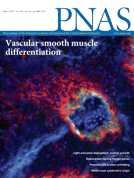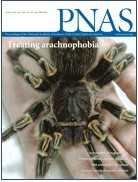PNAS:抑制热休克蛋白27诱导人乳腺癌长期休眠
2012-06-26 Beyond 生物谷
肿瘤领域科学家一直在探寻肿瘤休眠的机制,但一直没有得到很好的研究发现。 近日,发表在PNAS杂志上的研究中,研究人员介绍了一种实验模型,该模型有助于研究人类肿瘤休眠与血管生成之间的相互作用,该研究证实局部血管内皮生长因子-A和碱性成纤维细胞生长因子的增加加速了血管生成开关的开启。 在乳腺癌异种移植模型(MDA-MB-436细胞)中,差异表达基因分析发现与不具有血管生成作用的细胞相比,热休克蛋白
肿瘤领域科学家一直在探寻肿瘤休眠的机制,但一直没有得到很好的研究发现。
近日,发表在PNAS杂志上的研究中,研究人员介绍了一种实验模型,该模型有助于研究人类肿瘤休眠与血管生成之间的相互作用,该研究证实局部血管内皮生长因子-A和碱性成纤维细胞生长因子的增加加速了血管生成开关的开启。
在乳腺癌异种移植模型(MDA-MB-436细胞)中,差异表达基因分析发现与不具有血管生成作用的细胞相比,热休克蛋白27(HSP27)在促血管生成的肿瘤细胞中显著上调。研究人员进一步评估HSP27表达下调在细胞株、小鼠模型上的影响,并进一步分析了人类乳腺癌和黑色素瘤患者临床数据集,明确其作用。结果发现体内肿瘤休眠后血管生成肿瘤细胞HSP27稳定下调。引人注目的是只有30个HSP27中的4个被敲除后,异种移植肿瘤70后天才开始快速增长,这与HSP27蛋白表达的恢复相关。值得注意的是,不表达HSP27的肿瘤都逃避不了休眠期。
HSP27的下调降低血管内皮细胞增殖, VEGF-A,VEGF-C和碱性成纤维细胞生长因子的分泌也减少。相反,在不具备血管生成作用的细胞中HSP27的过表达导致体内的肿瘤快速生长。经临床验证,HSP27蛋白表达与侵略性的肿瘤标志物和乳腺癌、黑色素瘤患者生存降低。研究结果揭示了HSP27在平衡肿瘤休眠和肿瘤进展,介导肿瘤血管生成中的关键作用,针对HSP27可能是癌症治疗新的有用的策略之一。

doi:10.1073/pnas.1017909109
PMC:
PMID:
Suppression of heat shock protein 27 induces long-term dormancy in human breast cancer
Oddbjrn Straume, Takeshi Shimamurad, Michael J. G. Lampaa,b, Julian Carreterod, Anne M. yanh, Di Jia, et al.
The mechanisms underlying tumor dormancy have been elusive and not well characterized. We recently published an experimental model for the study of human tumor dormancy and the role of angiogenesis, and reported that the angiogenic switch was preceded by a local increase in VEGF-A and basic fibroblast growth factor. In this breast cancer xenograft model (MDA-MB-436 cells), analysis of differentially expressed genes revealed that heat shock protein 27 (HSP27) was significantly up-regulated in angiogenic cells compared with nonangiogenic cells. The effect of HSP27 down-regulation was further evaluated in cell lines, mouse models, and clinical datasets of human patients with breast cancer and melanoma. Stable down-regulation of HSP27 in angiogenic tumor cells was followed by long-term tumor dormancy in vivo. Strikingly, only 4 of 30 HSP27 knockdown xenograft tumors initiated rapid growth after day 70, in correlation with a regain of HSP27 protein expression. Significantly, no tumors escaped from dormancy without HSP27 expression. Down-regulation of HSP27 was associated with reduced endothelial cell proliferation and decreased secretion of VEGF-A, VEGF-C, and basic fibroblast growth factor. Conversely, overexpression of HSP27 in nonangiogenic cells resulted in expansive tumor growth in vivo. By clinical validation, strong HSP27 protein expression was associated with markers of aggressive tumors and decreased survival in patients with breast cancer and melanoma. An HSP27-associated gene expression signature was related to molecular subgroups and survival in breast cancer. Our findings suggest a role for HSP27 in the balance between tumor dormancy and tumor progression, mediated by tumor–vascular interactions. Targeting HSP27 might offer a useful strategy in cancer treatment.
本网站所有内容来源注明为“梅斯医学”或“MedSci原创”的文字、图片和音视频资料,版权均属于梅斯医学所有。非经授权,任何媒体、网站或个人不得转载,授权转载时须注明来源为“梅斯医学”。其它来源的文章系转载文章,或“梅斯号”自媒体发布的文章,仅系出于传递更多信息之目的,本站仅负责审核内容合规,其内容不代表本站立场,本站不负责内容的准确性和版权。如果存在侵权、或不希望被转载的媒体或个人可与我们联系,我们将立即进行删除处理。
在此留言














#PNAS#
70
#热休克蛋白#
79
#休眠#
72